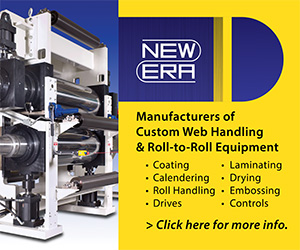Making Choices for Coating with a Laminating Adhesive
- Published: October 01, 2001, By David J. Bentley Jr., RBS Technologies
Work, like life, is full of choices. Some are major; some are the kind we face every day. Converters laminating two substrates together using an adhesive must choose the substrate on which to apply the adhesive. This choice depends on various factors.
The first consideration in selecting the substrate to coat concerns the adhesive being used. Laminating adhesives come in a variety of types that can have different forms. They can be aqueous systems; solvent systems; high solids or 100% solids materials; or hot melt products.
Each class of adhesive can have a specific influence on a substrate. Obviously, converters should avoid coating aqueous adhesives on substrates that water can harm, such as paper. Adhesives supplied in solvent systems likewise should not be applied to substrates that are sensitive to the particular solvents in the adhesives. When using an adhesive that is applied at an elevated temperature, one should not coat it on a substrate that is sensitive to heat, such as some polyolefin films.
Some substrates in a lamination actually are not simple materials but coated products. In such a case, the converter selecting a substrate for coating must consider the characteristics of the coating. An aqueous adhesive is not suitable for coating on the side of a substrate having a water-sensitive coating. An adhesive in a solvent system is not appropriate for coating on the side of a substrate having a solvent-sensitive coating. Converters should not use adhesives applied at elevated temperatures on the side of a substrate having a heat-sensitive coating.
In summary, the water, solvent, or heat resistance of a substrate itself or to a coating on the substrate is an important factor when selecting a substrate for coating with a laminating adhesive. Other factors also require consideration.
Adhesives supplied in water or solvent need drying in an oven after application. Heat-sensitive substrates are, therefore, inappropriate as substrates for coating in most cases requiring drying. The exposure to heat in an oven might cause a substrate such as paper to dry excessively or shrink or distort, as might occur with a polyolefin material.
Another factor to consider when selecting a substrate to coat is the exposure of the substrate to the stresses of travel through a laminator. The substrate being coated will experience unwinding, coating with adhesive, drying for aqueous or solvent systems, lamination in a nip, and rewinding. It also will pass over many idler rolls and undergo the tension necessary to pull it through the laminating operation. The secondary substrate experiences only unrolling, laminating in a nip, and rewinding. Because it travels a shorter distance, it does not experience the same stresses as the primary substrate. For these reasons, a polyester film will be a better choice for the primary substrate than a polyolefin film.
The physical characteristics of a substrate itself influence its possible selection as the proper substrate to coat. Consider paper as an example. Depending on the particular grade or thickness of paper, it may be prone to tear easily. For this reason, it might not be a suitable substrate for coating. Aluminum foil is another example. For economical reasons, converters prefer to use the thinnest aluminum foil possible. This means it also is prone to web breaks with only the slightest nick to the foil. Metallized films might have their metallic coating scratched or abraded during travel through a laminator as the coated substrate.
Converters, therefore, choose the film on which to coat a laminating adhesive by considering all the properties and characteristics of both substrates in the lamination they want to make. Neither substrate probably is perfect for undergoing the rigors of the laminating operation. One substrate will have better resistance to water, solvent, heat, tearing, etc., than the other. That substrate is the obvious choice for the laminator to make.
David J. Bentley Jr. is a recognized industry expert in polymers, laminations, and coatings with more than 30 years of experience in R&D and technical service. Contact him at e-mail: dbentley@unm.edu.







